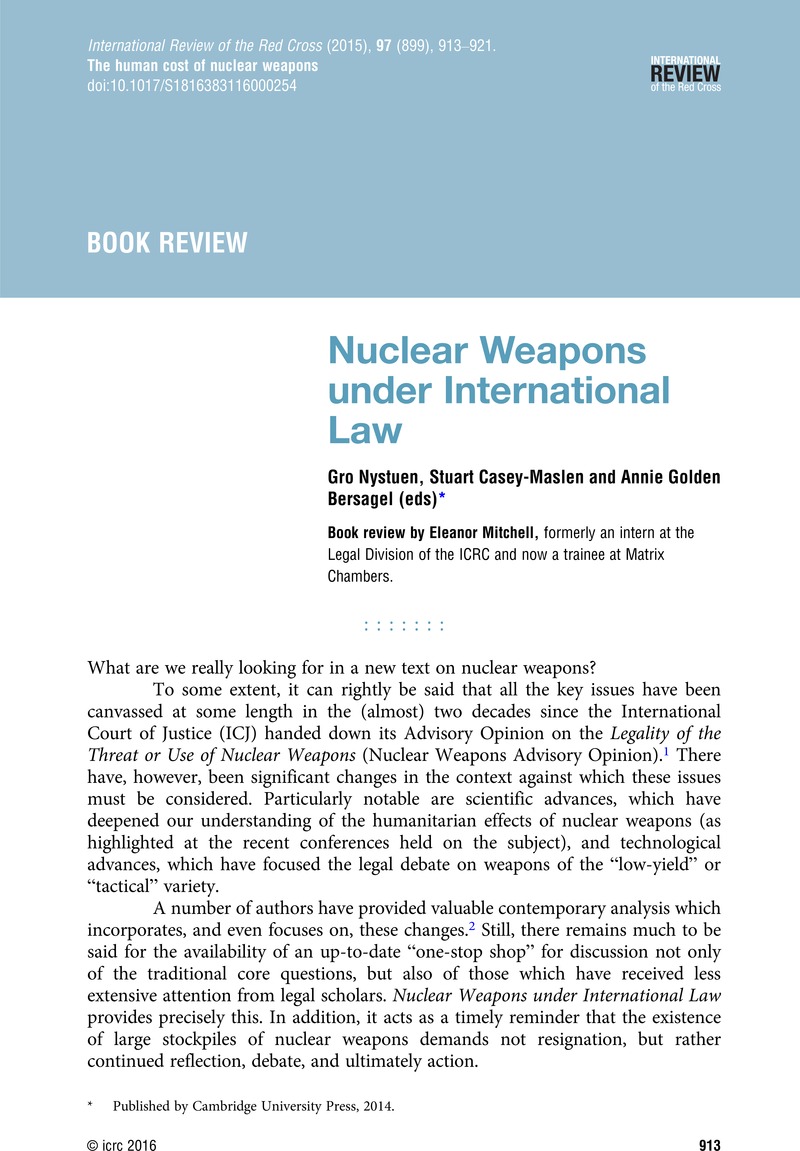No CrossRef data available.
Published online by Cambridge University Press: 30 May 2016

1 ICJ, Legality of the Threat or Use of Nuclear Weapons, Advisory Opinion, 8 July 1996, ICJ Reports 1996 (Nuclear Weapons Advisory Opinion).
2 See, e.g., Rudesill, Dakota, “Regulating Tactical Nuclear Weapons”, Georgetown Law Journal, Vol. 102, 2013Google Scholar; Moxley, Charles, Burroughs, John and Granoff, Jonathan, “Nuclear Weapons and Compliance with International Humanitarian Law and the Nuclear Non-Proliferation Treaty”, Fordham International Law Journal, Vol. 34, No. 4, 2011Google Scholar; Moxley, Charles, “The Unlawfulness of the Use or Threat of Use of Nuclear Weapons”, ILSA Journal of International and Comparative Law, Vol. 8, 2002Google Scholar; Breau, Susan, “Low-Yield Tactical Nuclear Weapons and the Rule of Distinction”, Flinders Law Journal, Vol. 15, No. 2, 2013Google Scholar; Chatham, Robert, “Tactical Nuclear Weapons”, The Reporter, Vol. 37, No. 2, 2010Google Scholar.
3 Nuclear Weapons under International Law, pp. 17–24.
4 Namely, that it could not “conclude definitively” whether the use of nuclear weapons would be unlawful “in an extreme circumstance of self-defence, in which the very survival of the State would be at stake.” Nuclear Weapons Advisory Opinion, above note 1, para. 105(2)(E).
5 Nuclear Weapons under International Law, pp. 28–29.
6 Ibid., p. 30.
7 Hayashi accurately points out the remarkable unhelpfulness of the ICJ's apparent conflation of a “threat” with an “unlawful threat”: Ibid., pp. 39–40, 51.
8 Ibid., p. 51.
9 The classic example would run along the lines of “an act or statement of State A which could reasonably, given the circumstances, be interpreted as communicating an intention to use force against State B”. Consideration could then be given to whether this should simply raise the presumption of a “threat”, which could be rebutted by evidence either that this was not State A's intention or that State B did not understand it to be so. Also relevant here would be Hayashi's discussion of the relationship between effectiveness and credibility: see pp. 54–55.
10 Essentially that, if using force is unlawful, a threat to use it must be equally unlawful.
11 Nuclear Weapons under International Law, pp. 42–46, 55–56.
12 Ibid., pp. 85–86.
13 Ibid., p. 126.
14 Ibid., pp. 122–123.
15 Ibid., p. 123.
16 See, e.g., D. Rudesill, above note 2.
17 O'Connor gives the alternate example of the bombing of a military installation in a desert area: Nuclear Weapons under International Law, p. 146.
18 Ibid., p. 141.
19 If so – and this is perhaps a useful link to draw – the attacker would arguably be required to select any conventional weapon likely to cause either less civilian harm or less suffering to combatants, leaving the scope for the use of nuclear weapons narrow indeed.
20 Nuclear Weapons under International Law, p. 146.
21 See Louis Maresca and Eleanor Mitchell, “The Human Costs and Legal Consequences of Nuclear Weapons under International Humanitarian Law”, in this issue of the Review. See also Jakob Kellenberger, “Bringing the Era of Nuclear Weapons to an End”, statement, 20 April 2010; and Peter Maurer, “Nuclear Weapons: Ending a Threat to Humanity”, speech, 18 February 2015, both available in the “Reports and Documents” section of this issue of the Review.
22 Nuclear Weapons under International Law, p. 204.
23 Ibid., pp. 215–220.
24 Ibid., p. 240.
25 Ibid., pp. 254–256.
26 Ibid., pp. 356–357.
27 Ibid., p. 305.
28 Ibid., pp. 316–317.
29 Ibid., p. 396.
30 Ibid., p. 417.
31 Ibid., p. 414.
32 Ibid., pp. 444–449.
33 Ibid., pp. 452–454.
34 Ibid., p. 459.
35 Ibid., p. 461.
36 Ibid., p. 486.